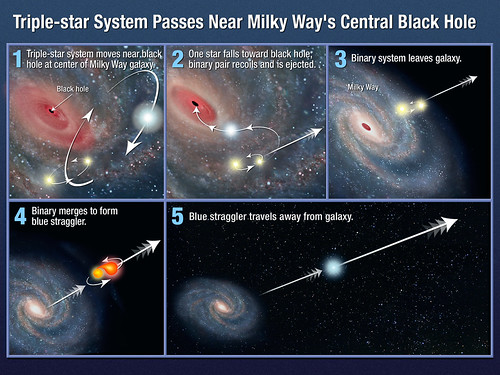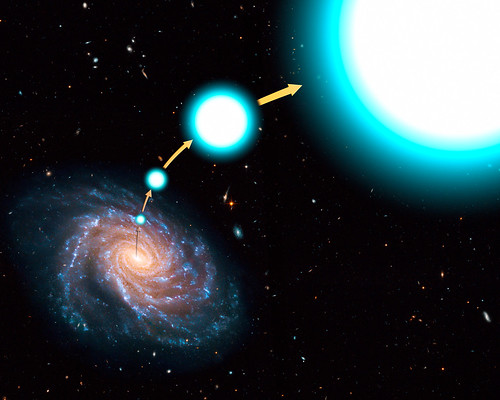Next Stop: Shooting Stars
- By Jason McCracken
- July 3, 2013
- Comments Off on Next Stop: Shooting Stars
Last time, we set ourselves up with a nice place to cool off and had a drink or two. And as the evening rolls up, we can lay back with our drinks, dipping our feet in the distant APM 08279+5255 quasar, and watch the universe set. Maybe we can catch a shooting star or two. Of course, I am referring to an actual star shooting across the sky!
Possibly the most studied star that is hurling around the Milky Way is Mira A (Latin for wonderful). Clocking in at around 291,000 miles per hour, Mira A is part of a binary star system (Mira A and Mira B) with a 500-year orbit around its partner, which can be seen in the constellation Cetus from Earth. Mira is also a swollen red giant. A red giant is a small-to-average mass star that is nearing the end of its life. Inside our Sun, a prime example of a small-to-average mass star, nuclear reactions happen constantly as hydrogen fuses into helium. But when the hydrogen runs out in one of these stars (as will happen in the Sun in billions of years), the star will begin to contract, causing immense pressure and energy. This causes the star to expand greatly into a red giant. If Mira A were to magically swap places with the Sun, it would engulf everything out to Mars. What makes Mira A so spectacular, though, is its tail. We’ve actually known about Mira for about 400 years, but it wasn’t until recently that we’ve exposed what is really going on. As Mira travels through space with her companion, she leaves behind mass as she burns fuel. This mass gives off light in ultraviolet wavelengths, and it wasn’t until 2007 when she was viewed with the Galaxy Evolution Explorer (GALEX) that we saw her tail. Hold on to your hats, because it’s a head turner.
Mira had had it. Twinkle, twinkle “LITTLE” star?
Animation of Mira A
Credit: NASA/JPL-Caltech
Mira A’s tail is about 15 light years long – meaning it takes light 15 years to travel from one end to the other. This is 20,000 times longer than the average distance between the Sun and Pluto, by no means a meager distance. And this tail has been growing for 30,000 years. What’s most excellent is that the material deposited by this tail can actually be recycled into new stars, planets and possibly life.

Did somebody get the license plate of that star?
Actual UV image of Mira A
Credit: NASA/JPL-Caltech
And don’t believe for a second that that’s all I have to offer. While Mira is traveling at speeds much faster than other stars (which travel at a comparatively leisurely average speed of 44,738 miles per hour), she is by no means the fastest, and she is still bound to the Milky Way. In 2005, astronomers discovered what they call hyper velocity stars (HVS). To become a HVS, the speed of a star has to exceed the escape velocity of a galaxy which in turn allows it to potentially leave the galaxy. That is, the star has to be going fast enough to overcome all of the gravitational pull that holds it in the galaxy. What?! Let’s scale things back for a moment. Earth has gravity, and that gravity allows us to meander about and not just drift off into space. What’s more important is that if you jump on Earth, you always come back down. You just can’t move fast enough to escape Earth’s loving grip. However, a rocket traveling faster than 25,054 mph (Earth’s escape velocity) can leave this planet and travel to the moon, or beyond. The escape velocity at our current distance from the center of the galaxy is around 1,000 kilometers per second or 2,236,936 miles per hour. So escaping the Milky Way requires a tremendous amount of energy and speed! (Try it. You won’t get far.) So how do these few stars achieve this feat?

There will be a test after the blog.
Credit: NASA, ESA, and A. Feild (STScI)
Astronomers believe that these celestial speeders are the product of binary (or even triple) star systems getting just a little too close to a super-massive black hole – one star gets captured and the other gets sling-shot into the galaxy. It’s a horrible break up. Other theories suggest that a small galaxy collided with ours, and during the collision, unleashed the HVSs upon us. Others still think most of them originated in the Large Magellanic Cloud (one of our neighboring galaxies), and a small group of 675 stars just outside our galaxy are being studied right now with the thought that they might be a cluster of HVSs. There are thought to be roughly 1000 HVSs in the Milky Way alone, which is a small fraction (~0.00001%) of the 100 billion “normal” stars in our galaxy.

And sadly, SDSS J090744.99+024506.8 was never seen again.
Illustration of an expulsion of an HVS from a galaxy
Credit: NASA, ESA, and G. Bacon (STScI)
What’s great about HVSs is that throughout their life they will travel through most of the galaxy. By measuring the motion of these stars, we can get insight into the shape of the Milky Way, and we can also discern information on the presence of dark matter by measuring the trajectory of an HVS when it leaves the galaxy. This trajectory will be affected by the gravitational force of dark matter, and help scientists figure out how much of this matter is hanging around.
Now take a deep breath. I understand that the knowledge of giant stars flying around the galaxy at speeds unfathomable (to anyone not wearing a red onesie) may be a bit unsettling. Just remember that HVSs are a very small percent of stars out there, and as a solar system we aren’t just sitting around waiting for a game of galactic bowling. Our solar system is also running around the galaxy as well (at about about 483,000 miles per hour). Furthermore, the rest of the universe (besides the very few rogue objects) tends to be bound in an orbit (like around the center of our galaxy) and has been moving in this orbit for an incredibly long time (billions of years long), governed by laws of physics as we understand them. So it’s unlikely we would need to do, well, nothing because there wouldn’t be much we could do if something was coming our way. Sleep easy…
So on our adventure through the cosmos, we have found an incredibly large pool of water, an immense vat of ethanol, and now real shooting stars. Let’s strap in and keep going, and maybe we can snatch a diamond, or at least a diamond planet. As always, leave a comment or two, and maybe we can make a detour.


